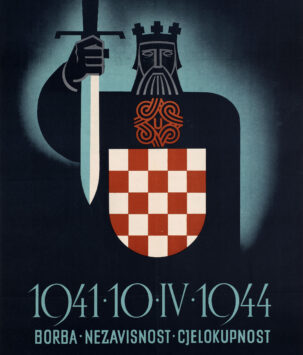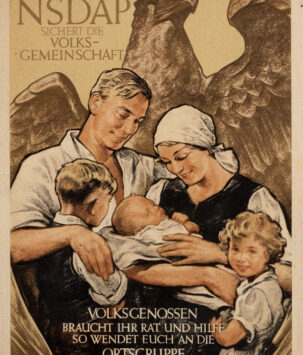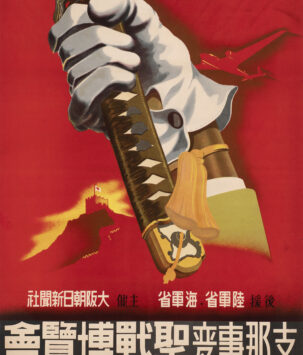Showing 1–12 of 25 results
-
Belgian recruitment poster for the Waffen-SS replacement troops. Illustrated by F. Bertau in 1944, the poster is unparalleled in its dynamism and visual literacy. The potent symbolism and cartoonish style make the piece both unique to the era and unlike any other from it. A visually entertaining poster that manages to non-verbally communicate all its intended ideas through its vivid composition and succinct symbolism.
-

Schutzstaffel (SS) recruitment poster from German-occupied Norway brimming with mythological imagery from Germanic Paganism. Found within this poster is a profound esoteric symbology that captures the essence of neopagan National Socialist cosmology. Combining the quadratic themes of each arm of the swastika presents a singular, divine whole. The horizontal axis represents temporality, with the left and right arms symbolizing past and present, respectively, while the vertical axis represents the theory of metaphysical dualism. An iconic element of Norway’s heritage, ancient Vikings warriors are reflected on the right by their modern descendants, legionnaires of the Norwegian Waffen-SS. In the center is the revered god of war, Odin. The cosmic tree Yggdrasil forms the top arm as the axis mundi of Norse cosmology, bridging the celestial realms to the terrestrial, rooted in our soil but with its branches reaching far into the heavens. A humble Aryan family and a valiant SS patriarch comprising the bottom arm can be seen defending his homestead from the ravenous dragon of Judeo-Bolshevism.
-
Election poster promoting Norway’s far-right Nasjonal Samling (National Assembly) party, founded in May 1933 by Vidkun Quisling. The sun in the form of a pagan sun cross rises behind a raven which was veneratedin old Norse Viking mythology as Odin’s divine messenger. Akin to the German National Socialists they were modeled on, the Nasjonal Samling rejected Christianity and drew much of its imagery from paganism which they saw as a more authentically Norwegian faith. Although the party never enjoyed any electoral success, Quisling and his party collaborated with the Germans upon the invasion of Norway. Following his deposition in 1945, the very term ‘Quisling’ would later become synonymous with ‘traitor’ in the Scandinavian languages.
-
Poster celebrating the establishment of the Independent State of Croatia. An ethereal nimbus of light surrounds a king bearing the insignia of the Ustaše.
-
The Volksgemeinschaft (people’s community) refers to a homogenous national community in citizens are united by a common culture, language and goal as well as a shared sense of identity that would overcome class conflict. It is characterized by solidarity, cohesion and equality, and expects the selfless devotion of every individual towards the betterment of the larger community which is considered an extension of oneself.
-
A grand array of military aircraft soaring above the national and war flags of Japan highlights the empire’s boundless and unrelenting military might. Japanese propaganda poster calling for the purchase of war bonds.
-
A stoic figure is depicted with stone-like ruggedness illuminated by the light of hope. Japanese poster calling for the spiritual mobilization of its populace to steel themselves for the upcoming struggle. The text and imagery alludes to the stoic character of the Japanese people and calls for them to exercise this iron-willed determination in the face of adversity.
-
Japanese poster promoting an exposition in support of the Second Sino-Japanese War. A katana is raised triumphantly above the backdrop of the Great Wall of China flying a Japanese flag. Signifies Japanese primacy over China while also extolling Japan’s martial heritage. Following the Japanese invasion of Manchuria in 1931, easterly portions of the Great Wall were indeed controlled by the occupying Japanese forces up until their surrender in 1945.
-
A potent Waffen-SS recruitment poster from the occupied Netherlands. A legion of stormtroopers march in unison surmounted by an array of artillery guns and lead by a platoon of tanks, all of which comprise an earthy foreground and gives the poster its sturdy visual foundation. The profile of a stoic, faceless stormtrooper hovers assertively above his comrades in a darkened sky lined with bombers. One of the most iconic pieces of modern propaganda.
-
Dutch poster during the German occupation promoting an exhibition about the economic and cultural revival of the Netherlands. A Wolfsangel, the symbol of Dutch National Socialism, is displayed prominently in the middle. A sword and spade, symbolizing the dual pillars of National Socialism, surmount the Wolfsangel: The sword embodies the iron will of the ‘nation’ and its Volk, while the spade represents the ‘social’ commitment to self-improvement, charity, and compassion for fellow citizens in the pursuit of economic autarky.
-
A poster from the German-occupied Netherlands juxtaposing an antiquated Dutch three-decker with a modern German U-boat with the Germanic allies setting sail for London. The Germans sought to win over the Dutch by reigniting feelings of the historical Anglo-Dutch naval rivalry. The two preeminent seafaring nations of western Europe can trace their enmity back to the year 1673 as referenced on the poster, during which the Third Anglo-Dutch War took place. It was the last successful invasion of the British isles by a foreign power.
-
Irredentist lithograph by Alberto Martini depicting an ethereal personification of Italy as she stands triumphantly over the Austro-Hungarian Empire. Austria-Hungary is represented by a beastly reptilian interpretation of Emperor Franz-Joseph,, seen claiming rightfully Italian lands for himself.











